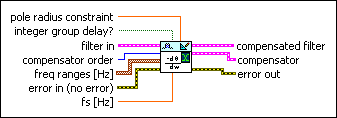DFD Group Delay Compensator VI
Owning Palette: Special Filter Design VIs
Installed With: Digital Filter Design Toolkit
Compensates the group delay of a filter.
The resulting filter, compensated filter, has the same magnitude response as the original filter but includes a constant group delay in the frequency ranges you specify.

 Place on the block diagram Place on the block diagram |  Find on the Functions palette Find on the Functions palette |
 | pole radius constraint specifies the maximum pole radius for the new filter. The default is 0.99. A small pole radius constraint decreases the possibility of filter instability caused by finite precision effects. However, a small value of the pole radius constraint can adversely affect the potential sharpness of the group delay response. The valid values for pole radius constraint are within the range (0, 1]. This VI ignores the input and applies no constraint to the radius if a value is beyond the range. | ||||||
 | integer group delay? specifies whether group delay for the new filter is an integer. The default is TRUE. If you set integer group delay? to FALSE, group delay is any real number. | ||||||
 | filter in specifies the input filter. | ||||||
 | compensator order specifies the order of the allpass filter that compensator returns, which compensates group delay. compensator order must be an even number. | ||||||
 | freq ranges specifies one or more frequency ranges in which this VI compensates the group delay.
| ||||||
 | error in describes error conditions that occur before this VI or function runs.
The default is no error. If an error occurred before this VI or function runs, the VI or function passes the error in value to error out. This VI or function runs normally only if no error occurred before this VI or function runs. If an error occurs while this VI or function runs, it runs normally and sets its own error status in error out. Use the Simple Error Handler or General Error Handler VIs to display the description of the error code. Use error in and error out to check errors and to specify execution order by wiring error out from one node to error in of the next node.
| ||||||
 | fs specifies the sampling frequency in hertz. The value must be greater than zero. The default is 1, which is the normalized sampling frequency. | ||||||
 | compensated filter returns the new filter with compensated group delay. | ||||||
 | compensator returns the allpass filter that the VI uses to compensate the group delay. | ||||||
 | error out contains error information. If error in indicates that an error occurred before this VI or function ran, error out contains the same error information. Otherwise, it describes the error status that this VI or function produces.
Right-click the error out front panel indicator and select Explain Error from the shortcut menu for more information about the error.
|
Example
Refer to the Group Delay Compensation VI in the labview\examples\Digital Filter Design\Floating-Point Filters\Conventional directory for an example of using the DFD Group Delay Compensator VI.



